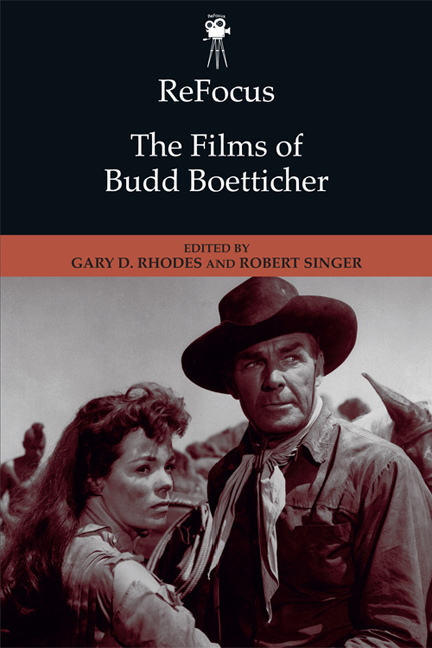Book contents
- Frontmatter
- Contents
- Notes on Contributors
- Dedication
- Introduction
- Part 1 The Non-Westerns
- Part 2 The Westerns
- Part 2 Introduction
- 7 The Ranown Cycle: Budd Boetticher's “New Look” Western Programmers in 1950s Hollywood
- 8 Framings, Motifs, and Floating Poker Games in Seven Men from Now (1956)
- 9 The Ranown Style: Mapping Textual Echoes
- 10 You Were Married, But You Never Had a Wife: The Use of Space in the Westerns of Budd Boetticher
- 11 Ideology and Boetticher's Westerns from the Late 1950s
- 12 Outlaws Without a Cause: Generational Conflict in Budd Boetticher's Ranown Cycle
- 13 The Box in the Desert: Budd Boetticher, Breaking Bad, and the Twenty-first-century Western
- Index
11 - Ideology and Boetticher's Westerns from the Late 1950s
from Part 2 - The Westerns
Published online by Cambridge University Press: 22 December 2017
- Frontmatter
- Contents
- Notes on Contributors
- Dedication
- Introduction
- Part 1 The Non-Westerns
- Part 2 The Westerns
- Part 2 Introduction
- 7 The Ranown Cycle: Budd Boetticher's “New Look” Western Programmers in 1950s Hollywood
- 8 Framings, Motifs, and Floating Poker Games in Seven Men from Now (1956)
- 9 The Ranown Style: Mapping Textual Echoes
- 10 You Were Married, But You Never Had a Wife: The Use of Space in the Westerns of Budd Boetticher
- 11 Ideology and Boetticher's Westerns from the Late 1950s
- 12 Outlaws Without a Cause: Generational Conflict in Budd Boetticher's Ranown Cycle
- 13 The Box in the Desert: Budd Boetticher, Breaking Bad, and the Twenty-first-century Western
- Index
Summary
The Westerns Budd Boetticher made in collaboration with scriptwriter Burt Kennedy in the late 1950s: Seven Men From Now (1956), The Tall T (1957), Ride Lonesome (1959) and Comanche Station (1960) demonstrate the use of classic narrative structural arcs and display considerable depth of characterization. The speech patterns employed in the script lend themselves to the creation of carefully directed dramatic performances; the tensions between characters created in the writing demand expression in the proxemics employed in shot composition; and the locations set out in the screenplay require the almost unavoidable creation of poetic sequences highlighting the relationship between man and the natural world. But what are the underpinning messages and ideologies of these Boetticher–Kennedy Westerns and how is the nature of this worldview revealed when set alongside Boetticher Westerns from the same period with screenplays by Charles Lang, Decision at Sundown (1957) and Buchanan Rides Alone (1958), and Berne Giler Westbound (1959)?
If anyone were to be in any doubt as to why Boetticher is seen by many as a high-quality Hollywood director, they would need only to study the opening five minutes of The Tall T to understand exactly how he has gained such a reputation. The first shot is of a rocky, boulder-strewn landscape that immediately presents itself as a harsh, unforgiving environment. In the distance there are two arid and dusty hills and, beyond that, there is a cloudless, grey-blue sky. The whole area from the far distance into the foreground is dry, barren and largely devoid of greenery. The static camera invites the viewer to take in this landscape as the credits fade in across the screen in a broken, jagged font and an orangey red that immediately brings to the semiotic mix the usual foreboding connotations attaching to that color. As we move toward the end of the credit sequence, a horse and rider (Randolph Scott as Pat Brennan), minute within the composition of the shot, enter the middle distance from behind a large boulder on the left of the screen and move toward a fixed camera point, weaving between rocks. The rider sways and shifts in the saddle according to the changes in terrain in a choreographed expression of a particular relationship between man and nature.
- Type
- Chapter
- Information
- ReFocus: The Films of Budd Boetticher , pp. 188 - 205Publisher: Edinburgh University PressPrint publication year: 2017



